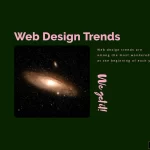Web design ideas are indispensable these days, for they help make the web a place where people can enjoy themselves. This post is quite wide and it goes deep in the various new creative concepts and techniques that can not only arouse the interest of learners who are just starting out but can also motivate the keen graphic artist to the higher levels of the craft.
Enhancing Visual Appeal through Dynamic Color Schemes and Typography
A website’s visual aesthetics are the key to attracting and keeping the attention of users. Skilled use of color combinations and the perfect choice of font will help designers create unforgettable web designs that are timeless and trendy at the same time.
Innovative Color Palette Techniques
- Gradient Overlays: This approach can be applied by adding minute color transitions in order to depict what is deep-end relatively through them.
- Duotone Effects: Here’s the simple strategy to use for you, mix only two colors to create vivid and dramatic contrasts.
- Color Psychology: This is the way to take the emotional dimension of colors into account in order to make sure a brand message is delivered properly and effectively.
Typography Trends
- Variable Fonts: Variability in styles and weights of the font makes it the most suitable means to create fonts that respond ambiently and in desired forms.
- Custom Typefaces: By designing letters that are new, a company is making a positive statement by adding visible brand appropriateness and recall.
- Kinetic Typography: Try it and watch how moving text will engage users and explain things in a more exciting and dynamic way.
Not only do the designers mix up shades and typefaces, they also maintain the consistency of the brand. This way, the website becomes a coherent and enjoyable user experience throughout its lifetime.
Optimizing Layout and Visual Hierarchy for Enhanced User Experience
The right layout of a website is very important for directing the users through the content and for giving them a pleasant time in the meantime. Combining novel site designs with a powerful visual hierarchy can ensure that the website is esthetically appealing and functional.
Advanced Layout Concepts
- Asymmetrical Layouts: In this case, users are provided the opportunity to form their own patterns with the use of the grid off the center.
- Modular Design: It is designed to be a common set of components using in-building of various layouts and is absolutely scalable.
- Parallax Scrolling: It is a method that simulates infinite depth and its feel is lifelike and engrossing to the observer as it were.
Enhancing Visual Hierarchy
- Microinteractions: Micro-interactions feature short animations such as loading indicators and vibrations that assist to guide the user and enhance engagement.
- Negative Space: Use white space in a smart way and your page’s visual mess can soon turn into a very focused and meaningful content.
- Size and Scale: Placing elements at different sizes helps users see the relationship between them while allowing navigation through content.
Through the interaction of well-balanced layout systems and hierarchies, designers can create websites that allow the users to maneuver through the site without much effort and at the same time fetch information efficiently. Thus, this would lead to the users being more engaged and satisfied which in return leads to increased involvement and loyalty.
Embracing Responsive Design and Mobile Friendly Approaches
Today, the dominance of technology means that web designs should adapt regardless of the device type or orientation. Responsive design and mobile friendliness will guarantee that the sites are well presented and functional regardless of the devices used.
Responsive Design Strategies
- Fluid Grids: By smartly adjusting the layout in accordance with the dimension of the screens, they will ensure their site’s compatibility for smartphones and even other devices such as tablets and wearables.
- Flexible Images: These days, employing the method of making pictures proportionally large or small according to the display is more complex due to the variety of screens available.
- Media Queries: Web developers often use code to tell the browser to use specific stylesheets for different devices but with media queries, they will fully correct this problem.
Mobile-First Design Principles
- Touch-Friendly Interfaces: Designing mobile interfaces with interactive features that are easy to touch and swipe is a great idea for a satisfying user experience.
- Simplified Navigation: Menu organization, and selecting of menu items on smaller screens can be very hard, thus that must be the first priority to address in order to make it user-friendly.
- Performance Optimization: The main elements and features should receive emphasis as site load time is essential to mobile users.
Choice of mobile web design approach is a big factor whether websites will maintain the same quality of user experience across all between different devices and user interfaces. This implies that user satisfaction and google rankings would go up for such services.
Implementing Intuitive Navigation and Clear Calls-to-Action
Precise and concise navigation through the site is a must for any successful website. Besides, when there are logically calls-to-action in the correct places, people really do take action and buy things. Gosh!
Innovative Navigation Techniques
- Sticky Navigation: Load the website with a sticky header feature that provides a user with a navigation tool wrapped around the top of the website which remains there even after the user scrolls the web page.
- Hamburger Menus: Create a drop-down menu that is hidden in ordinary computer screen sizes but can be expanded to show the menu on small screens.
- Mega Menus: The dropdown option will be expanded to the level of the respective categories of items and the user will click on a link or use another mouse interaction to navigate to another page.
Effective Call-to-Action Strategies
- Contrasting Colors: Bright colors are employed to draw users’ eyes to the most critical information, prompting the playful use of conflicting blues, suns, oranges to serve this purpose.
- Strategic Placement: Positioning the calls-to-action in all the visible sections of the page will give a maximum return as far as user engagement is concerned.
- Action-Oriented Text: Framing the action in the form of a request that prompts the user to perceive a benefit will increase the problem of the prompt.
The synergy between their intuitive navigation layout and the calls-to-actions that are placed strategically on their pages, makes their websites sites that act as part of the performer, leading the user not only to engage themselves but also towards some desired actions as they be converted. And so the final objective is the achievement of business goals.
Enhancing User Engagement with Interactive Elements and Animations
Relying on non-intrusive yet valued interactive functions and some smooth small animations is the surest way of success in this dog-eat-dog world of customer service, for it keeps users on the site for longer and makes it more memorable for them. With this possibility, users can scroll the text and click to links, they can have mini-games as a sort of amusement, and the website might just be the most favorite one to them.
Engaging Interactive Elements
- Hover Effects: Briefly, the interactivity has to do with elements like interactions and mouse rollovers, which cause visual and/or functional changes to be displayed through them. In simple words, the system modifies colors or shapes based on the responses given by users.
- Scroll-Triggered Animations: Reports which include as tripartite elements color, animation, and layout effects will likely help achieve that brought a closer tie with the particular content or allowed it to remain in memory for a longer time.
- Interactive Infographics: Very often, users on the homepage can use mouse clicks to input or select values in the models, and the application recalculates the visualization of variables on-the-fly in response to the users’ selections.
Purposeful Animation Techniques:
- Microinteractions: Small virtual movements such as light flashes animation on hover or a scroll bar that can be moved by dragging the mouse among other actions bring the content closer to the user than before and make it easier to manage with.
- Loading Animations: Engaging animations can grab the attention of the user during the download process of any content.
- Parallax Effects: The smoother level and vertical movement of the different planes’ compositions as the users slide is the result of utilizing parallax-driven animation styles which boost the websites’ attractive features.
As the saying goes, users’ needs change with different technologies and new trends will carry to new ways of solving their problems. The main mission of designers, thus, must be looking for the user needs and considering their business goals.
Bringing It All Together
From the above, it emerges that the art of web design is moving along with the worldwide trends and technologies available. The newest inventions and fashions must not distract them from focusing on the most helpful elements, such as design for the user and business purposes.
Let’s not forget to combine visual appeal with simplicity and accessibility which really enable your site to catch the wind of the market. Often, pay attention to the load speed. It’s the only thing that will keep user’s interest and avoid you losing those opportunities coming your way. Branding is another key factor, continuity in logo application, design and much imagery will matter in the improvement of the brand.
The creative application of user-centered design principles to web projects will lead to the design of websites that are visually appealing and provide users with the best user experiences. The best web design ideas are those that are both visually attractive and functional, which creates an outstanding digital experience in the crowded online landscape.



